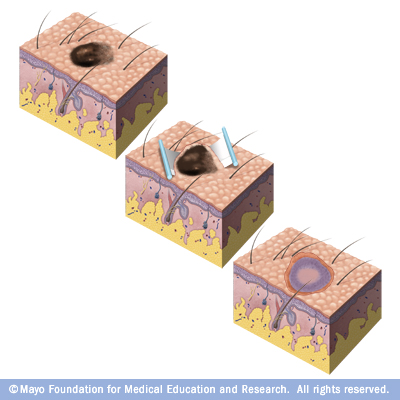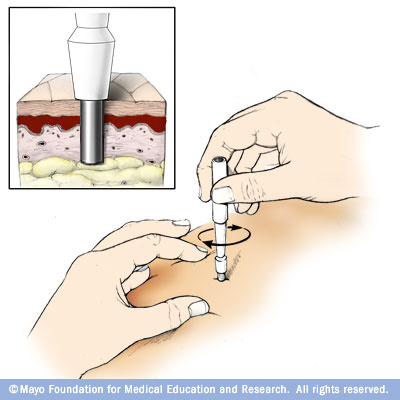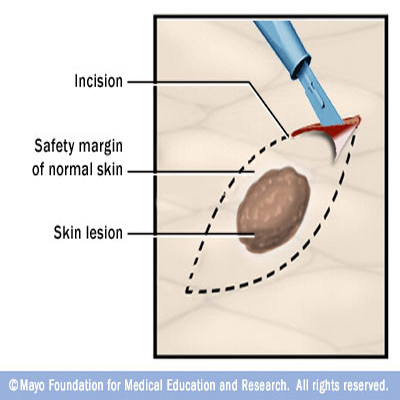Depending on the location of the skin biopsy, you may be asked to undress and change into a clean gown. A doctor or nurse then cleans the area of the skin to be biopsied. Your skin may be marked with a surgical marker or marking pen to outline the biopsy area.
You then receive a local anesthetic to numb the biopsy site. This is usually given by injection with a thin needle. The numbing medication can cause a burning sensation in the skin for a few seconds. Afterward, the biopsy site is numb and you shouldn't feel any pain or discomfort during the skin biopsy.
During the skin biopsy
What you can expect during your skin biopsy depends on the type of biopsy you'll undergo.
-
For a shave biopsy, your doctor uses a sharp tool, double-edged razor or scalpel to cut the tissue. The depth of the incision varies depending on the type of biopsy and the part of the body being biopsied. A shave biopsy causes bleeding. Bleeding is stopped by applying pressure to the area or by a combination of pressure and a topical medication applied to the biopsy site.
-
For a punch biopsy or an excisional biopsy, the procedure involves cutting into the top layer of fat beneath the skin, so stitches may be needed to close the wound. A dressing or adhesive bandage is then placed over the site to protect the wound and prevent bleeding.
A skin biopsy typically takes about 15 minutes total, including the preparation time, dressing the wound and instructions for at-home care.
After the skin biopsy
Your doctor may instruct you to keep the bandage over the biopsy site until the next day. Occasionally, the biopsy site bleeds after you leave the doctor's office. This is more likely in people taking blood-thinning medications. If this occurs, apply direct pressure to the wound for 10 to 20 minutes. If bleeding continues, contact your health care provider.
All biopsies cause a small scar. Some people develop a prominent, raised scar. The risk of this is increased when a biopsy is done on the neck or upper torso, such as the back or chest. Initially, the scar will be pink and then fade to white or sometimes brown. Scars fade gradually. The scar's permanent color will be evident one or two years after the biopsy.
Try not to bump the biopsy site area or do activities that might stretch the skin. Stretching the skin could cause the wound to bleed or enlarge the scar.
Healing of the wound can take several weeks, but is usually complete within two months. Wounds on legs and feet tend to heal slower than those on other areas of the body.
How to care for the biopsy site while it heals:
-
Wash your hands with soap and water before touching the biopsy site.
-
Wash the biopsy site with soap and water. If the biopsy site is on your scalp, use shampoo.
-
Rinse the site well.
-
Pat the site dry with a clean towel.
-
Cover the site with an adhesive bandage that allows the skin to ventilate.
Continue caring for the biopsy site until the stitches are removed. For shave biopsies that don't require stitches, continue wound care until the skin is healed.


